Project 667B nuclear missile attack submarines
 Project 667B Murena: 18 ballistic submarines (Delta I).
Project 667B Murena: 18 ballistic submarines (Delta I).
Soviet Cold War Subs
Pr.613 Whiskey | Pr.611 Zulu | Pr.615 Quebec | Pr.633 Romeo | Pr.651 Juliet | Pr.641 Foxtrot | Pr.641 buki Tango | Pr.877 KiloPr.627 kit November | Pr.659 Echo I | Pr.675 Echo II | Pr.671 Victor I | Pr.671RT Victor II | Pr.671RTMK Victor III | Pr.670/670M skat Charlie | Pr.705 lira Alfa | Pr.949 antey Oscar | Pr.945 Sierra | Pr.971 bars Akula | Pr.885 graney Yasen | Pr. 545 Laika
Pr.629 Golf | Pr.658 Hotel | Pr.667A Yankee | Pr.667B Murena Delta I | Pr.667D Delta II | Pr.667BDR Kalmar Delta III | Pr.667 BDMR delfin Delta IV | Pr. 941 akula Typhoon | Pr.995 borei Dolgorukiy | Pr.09851 Khabarovsk
Project 667B Murena (NATO Delta I) were a class of nuclear powered ballistic missile submarines (SSBN) derived closely from the previous Project 667A (NATO Yankee) but featuring the the D-9 complex, larger missiles and only twelve instead of sixteen. These R-29 ballistic missiles on board. They were studied by the Rubin Central Design Bureau of Mechanical Engineering under S. N. Kovalev. The R-29 missiles were 40% taller, 20% larger than their predecessor R-27 with twice as much in weight, but far greater range, allowing these SSBNs so stay out of the areas controlled by the US SOSUS submarine sonar system along the US coast. The R-29 longer range was to avoid detection.
The Murena project gave the USSR its second modern SSBN class, and inaugurated inside NATO the “Delta” designation for all major variants of the Project 667 family. The Delta IV being the last of them, the last built at the end of the wold war. The Delta I strongly resembled the Yankee but were sligghtly longer and development time was short. Since the missile fairing were taller, their silhouette gained a characteristic “hump” tht will only be accentuated in the following models. All 19 submarines were gradually withdrawn at the end of the cold war and beyond and disposed of, the last being dismantled in 2004.

Only open source photo of the Project 667B Murena, USN photo, courtesy of of Soviet Military Power, 1984. PHOTO No. 101, page 95.
Development
Military shipbuilding plan for 1969-1980.
To understand the shift triggerred by the Delta I class, were need to go back to the 1960s and the need to create a sustainable strategic nuclear underwater missile launching platform with long-range to complement land-based intercontinental ballistic missiles which still formed the basis of the Soviet Union’s nuclear missile arsenal. It was clear they were vulnerable of their location was discovered and motivated many ideas on how to avoid such discovery. The most obvious one was to make these mobile. All sorts of idea were played with. Trains, with nuclear launchers like the armoured RT-23 or Molodets (SS-24 Scalpel), armadas of heavy trucks erector launchers from four to nine axles, tracked launchers, helicopters (such as the V-12 “Homer”) and of course, the best platform possible, nuclear-powered SSBNs, that can escape detection and be anywhere ready to launch.
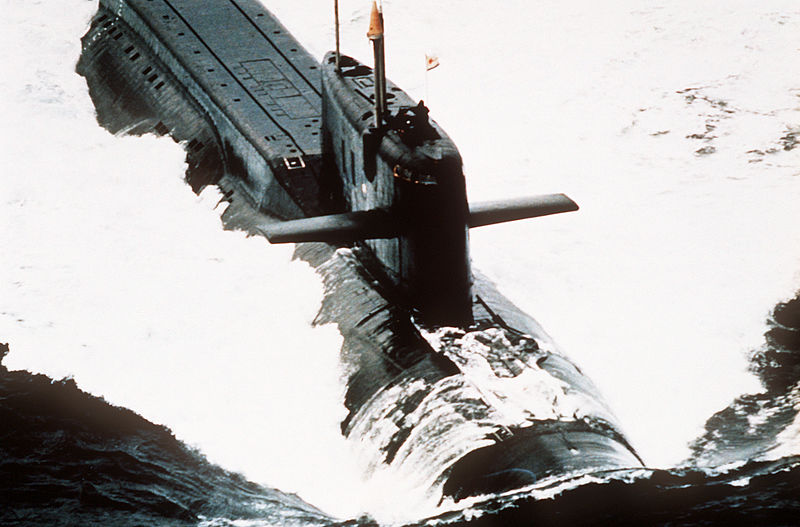
The late 1960s Project 667A Navaga (NATO Yankee)
The new military shipbuilding program setup planned to have new nuclear powered submarine missile carriers, which became the 2nd generation of Project 667. It also miirrored what was known about developments in the West, like the creation of the Polaris missiles family, an ICBM capable of 5,200 km in range and MIRV with 10-14 warheads. They were carried by the new Lafayette-class SSBNs and James Madison class (first re-equipped with Poseidons was SSBN-627 James Madison in service by June 28, 1970, and 31st SSBN-659 Will Rogers on February 8, 1974).
At the same time, Washington was setting up radical new solutions to hunt down Soviet SSBNs. The Soviet Navy top brass were well aware that the patrol areas chosen for the Project 627A (Yankee) would sson be under complete dominance of US Navy and NATO with fewer chances to escape detection and increased chanced of destruction at the start of a war. Therefore the Soviet Navy Commander-in-Chief demanded to increase firing range of ballistic missiles in order to widen combat patrol areas, closer to the shores of USSR.
About SOSUS
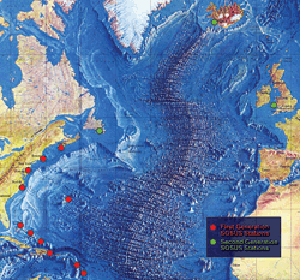 “Sound Surveillance System” (SOSUS) was a submarine detection system based on passive sonars, developed by the United States Navy to track Soviet submarines. It’s precise nature remained parly classified under this acronym to this very day. Officially it was named “Project Caesar” below a cover story regarding shore stations named “Naval Facilities” (NAVFAC) for oceanographic research. In 1985 this became the Integrated Undersea Surveillance System (IUSS) when the original fixed bottom arrays were complemented by the mobile Surveillance Towed Array Sensor System (SURTASS) but personal still officially worked for oceanographic duties until 1991 when it was mostly declassified.
“Sound Surveillance System” (SOSUS) was a submarine detection system based on passive sonars, developed by the United States Navy to track Soviet submarines. It’s precise nature remained parly classified under this acronym to this very day. Officially it was named “Project Caesar” below a cover story regarding shore stations named “Naval Facilities” (NAVFAC) for oceanographic research. In 1985 this became the Integrated Undersea Surveillance System (IUSS) when the original fixed bottom arrays were complemented by the mobile Surveillance Towed Array Sensor System (SURTASS) but personal still officially worked for oceanographic duties until 1991 when it was mostly declassified.
Its long ranges used the deep sound channel (SOFAR) and first detection was in July 1962 already when detecting a unreported sub (Non NATO) through the GIUK gap, from a station in Barbados. The project started in 1949 already and consisted in linear arrays with hydrophones using natural undesea slopes to create a sound channel processing sounds from far away to shore facilities as azimuthal beams. A contact picked up by three stations by triangulation provided approximate positions. The system was even maintained by dedicated ships such as the USNS Neptune (ARC-2), first cable repair ship formally assigned to Project Caesar. When a contact was made, a Lockheed Neptune or P-3 orion was sent to patrol the area and drop buoys to catch a precise bearing. More on this in a future update of the cold war USN page.
New Ballistic Missiles
The problem was looked for when converting some Project 667 boats for tests, but the whole issue was finally solved by V.P. Makeev when creating the two-stage ballistic missile RSM-40 with much greater firing range than the U.S. Trident 1. It was even capable of correcting its own flight trajectory using astro-correction and separating charges. This early ICBM was groundbreaking.
But the development of the second generation Soviet strategic submarine was to have better missile range notably through the D-9 missile system in development since 1963, increasing on paper three times one of D-6. The boats navigation system however required better accuracy than the traditional inertial guidance system. V.P. Makeev associated with variopus institutes, NIIA, NIIAP and the Geophysics center, started work on an on-board azimuth astro-correction system. It enabled to use star’s position to correct the trajectory in flight with greater accuracy.
Further improvement of the missile fire control system was aimed at shortining the pre-launch preparation up to 7 times and fire a full salvo faster.
There was of course a price to pay for this increase in performances and capabilites, traduced in size and weight. Compared to the R-27, the new ballistic missile’s height was increased by 40%, diameter by 20%, weight 50% so a new type of silo was to be designed to “squeeze” the new complex. It was indeed obvious to retake the 667A as a basis and modify it for the new missile, and so redo its entire missile sections, along with other changes. The first step was to downgrade missile capacity from sixteen to twelve, loosing four. However the whole Project had an effectiveness increase by 2.5 times compared to Project 667A.
Design work on Project 667B
The tactical and technical specifications (TTZ) for the modified SSBN carrying the D-9 complex was approved in 1965. Development was done under Projecy 667B since the base submarine was essentially the same as before. The more palatable code “Murena” was also referred internally at the Rubin Central Design Bureau, after the letters “MT” were assigned, and work proceeded under supervision of chief designer S.N. Kovalev. Chief observer for the Navy was Captain 1st Rank M.S. Fadeev, then Captain S.A. Novoselov. Since the base submarine was the same, development would proceed at a fairly fast pace, even ahead of the time with the new missile system. Test launches as a result started actually after the lead boat was commissioned. The missile complex was officially in service by March 12, 1974 indeed. Construction of 18 Project 667B boats was carried out at Severodvinsk, with ten built, and the remainder eight at Lenin Komsomol enabling a quick delivery.
Design of the class
Hull and general design
Design of the Murena repeated the the Navaga (Yankee) in all aspects, but the double-hulled had to be slightly enlarged to absorb the larger space taken by the silos. The pressure hull was divided into 10 waterproof compartments separated by thick bulkheads. All details about thicknesses and steel nature were the same as for the Navaga. Due to the taller missiles, most of the work concentrated on making the silos section fit in the existing hull. Still, taller and modified fairing were necessary. The characteristic “hump” which distinguished the Delta I from the Yankee were previous for identifications by NATO pilots when these subs were caught surfaced (rare), but the taller hump shadows projected at early or late hours were precious to identifiy these later underway or in port on U2/Blackbird/satellite photos.
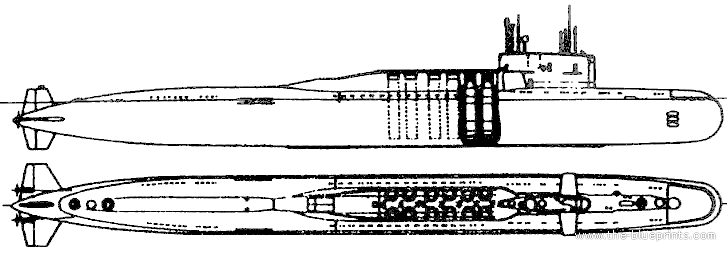
Powerplant
The Murena class had a Main power plant rated for 52,000 hp. and including two VM-4B pressurized water reactors plus two OK-700 steam turbines coupled with GTZA-635 turbo-gear units for smooth evolution. In addition there were two DG-460 diesel generators, two economical electric (creeping) motors rated for 260 hp each. To reduce hydroacoustic signature there was a two-stage damping for vibration prone systems on the steam turbine. They were much more advanced compared to the still noisy Yankee class.
The Murena also received the new Tobol-B navigation complex, comprising the Cyclone-B space navigation system responsible to provide accurate data for launch preparations, while underwater.
A newx autonomous shipborne digital computer system was also installed to control missiles with calculation of their trajectories faster and more accurately, taking weather conditions in context and ensuring smooth operation in order to have a faster launching sequence for a single salvo underwater.
Armament
Main: 12x SLBM (SSN-8 Sawfly)
 The D-9 missile complex represented a whole section of twelve 12 two-stage liquid-fueled missiles R-29 Vysota. GRAU designator was 4K75, internal designation was RSM-40 (mod.1) and Western designation SS-N-8 “sawfly”. Their maximum firing range was 7,800 km, enabling the SSBN to patrol just off the coast of the USSR and well outside areas of greatest ASW activity by NATO. These missiles used the same principles as the previous R-27 while featuring a set of advanced technical solutions and innovationse.
The D-9 missile complex represented a whole section of twelve 12 two-stage liquid-fueled missiles R-29 Vysota. GRAU designator was 4K75, internal designation was RSM-40 (mod.1) and Western designation SS-N-8 “sawfly”. Their maximum firing range was 7,800 km, enabling the SSBN to patrol just off the coast of the USSR and well outside areas of greatest ASW activity by NATO. These missiles used the same principles as the previous R-27 while featuring a set of advanced technical solutions and innovationse.
-In particular, the second stage engine was recessed into the first stage oxidizer tank creating a very compact design.
-The onboard control was based on a digital computer.
-There was an advance inertial missile control system with auto-correction based on star position (accuracy below 1,500 m=.
-Light decoys inside cylindrical containers welded into the second stage could be launched.
⚙ specifications R29 |
|
| Weight | 33.3 tons for launch |
| Dimensions | 13.435 x 1.8 m |
| Propulsion | 2 stages |
| Speed | |
| Range | |
| Guidance | |
| Ceiling | |
| Accuracy | |
| Payload | 1.1 tons 1 megaton bomb |
The R29 was produced by Krasnoyarsk Machine-Building Plant wit other centers in Siberia but the developemtna nd production process dragged on due to the complexity of the ensemble.
Control system
The Voskhod BIUS was the digital computer system Alpha in charge of real time calculation prior to launch, with the data transmitted to the missile at the last moment. The system ensure launched would even be semi-independent from the crew since it depended on a special order from the Supreme Command. A full salvo could be launched from under 55 m while cruising at 5 knots under a sea state up to force 6, if surfaced, which was also possible. A single missile, a pair or more could be launched also, but the entire salvo required a wide gap betwen silos to avoid interferences. Pre-launch preparation and launch were all carried out automatically at a latitude of the launch point up to 85° in the arctic, which was a world’s first.
Comparisons were done with the US Poseidon S-3 entering service almost simultaneously with the R-29. It had the same bulk of 29.5 tons but was MIRV capable, carrying ten warheads of 50 kg each with a maximum range of 4,600 km (60% the R-29 range). Accuracy (450 m) was however significantly higher. It could be fired under 15-30 m only, but longer for a single salvo with 15 lin. preparation time and longer intervals of one minute between launches.
In 1978, the modernized D-9D complex featured the R-29D ICBM, boasting a range of 9,100 km and increased accuracy (CEP 1000 m). Several Project 667B were so modernized as the 667BM. In 1986, it was modernized again.
⚙ specifications R-27/R27-U |
|
| Weight | 14,200 kg (31,300 lb) *R-27K: 13,250 kg (29,210 lb) |
| Dimensions | 8.890 m (29.17 ft) x 1.500 m (4.92 ft) *R-27K: 9m (29.528 ft) |
| Propulsion | N2O4/UDMH |
| Speed | boost time 128.5 Seconds |
| Range | 2,400 km (1,500 mi) *27U 3,000 km (1,900 mi) |
| Guidance | Inertial, launcher data |
| Accuracy | CEP 1.9 km (1.2 mi)** |
| Ceiling | 620 km (390 mi) |
| Payload | Single warhead 650 kg (1,430 lb), 1 MT yield* |
*R27U: 650 kg (1,430 lb) 1 MT yield or 3x 0.2 MT Warheads 170 kg (370 lb) each
**R-27U: CEP 1.3–1.8 km (0.81–1.12 mi), R-27K: CEP 0.37 km (0.23 mi)
Torpedo Armament
In the bow were four 533-mm torpedo tubes with a total of 12 torpedoes in reserve and two 400-mm torpedo tubes for the MG-44 decoy system. There were four main 21-in or 533 mm caliber were working for both anti-sub/ship torpedoes and two 400 mm (16 inches) caliber used the self-propelled decoys. Total was 16 torpedoes including two with nuclear warheads and four decoys. It is now known if they could accomodate another load of 12 like Project 667A.
Four main 21-in TTs
 The base torpedo could operate and be fired under 100 meters, wheras the two bow 400 mm tubes could be fired under 250 m. The torpedo tubes were equipped with fast loading and wire-guidance systems. The 21 inches initial model were SET 53M torpedoes, Heavyweight torpedo which entered service in 1964. They used a silver-zinc battery and running gear with reduced noise, with much longer range and higher speed.
The base torpedo could operate and be fired under 100 meters, wheras the two bow 400 mm tubes could be fired under 250 m. The torpedo tubes were equipped with fast loading and wire-guidance systems. The 21 inches initial model were SET 53M torpedoes, Heavyweight torpedo which entered service in 1964. They used a silver-zinc battery and running gear with reduced noise, with much longer range and higher speed.
The final adopted model was likely (unless reserved for SSNs) the 53-61M which entered service in 1969.
They were Acoustic wake following homing torpedo, based upon the 53-57 while the “M” has an improved homing system. Their engine was instable and dangerous however, using a Kerosene-Hydrogen Peroxide Turbine but enable a hit 15 km away at 55 knots (100 kph). They were the fastest before the introduction of cavitation model such as the Shkval.
⚙ specifications SET-53-61M |
|
| Weight | 1.480 kg |
| Dimensions | Length 7.8 m, Diameter 533 mm |
| Propulsion | Kerosene-Hydrogen Peroxide Turbine |
| Range/speed setting | 16,400 yards (15km)/55 knots or 24,000 yds (22 km)/35 kts |
| Warhead | 672 lbs. (305 kg), Electromagnetic proximity fuse 5m radius |
| Guidance | Passive acoustic homing, Sensor range unknown |
Sensors
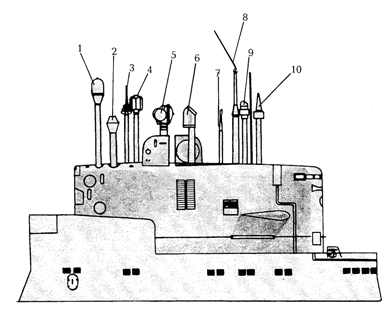
Electronic equipment:
-RLK-101 Albatros radar
-MGK-100 Kerch’ sonar
-Zaliv-P ECM suite
-MVU-100 Tucha CCS
Also, Project 667B was equipped with two combat information and control systems:
-BIUS “Almaz” system to control torpedoes, processing target data from the sonars, and pre-launch vectoring.
-RBUS “Alpha” Missile system main operating system.
Radio-Navigation equipments:
Radio communications, instead of a combination of various systems, was now integrated into a single complex for the first time, requiring less manpower, more automation. Also for the first time the Murena received the automatic space communication system “Molniya” as first Soviet satcom and a pop-up buoy-type antenna to received message while med-deep underwater.
What did not changed was the Kerch hydroacoustic complex (sonar set). Also the torpedo tubes had an autimated, faster loading system and the reactor core was to be only changed every 5.5 years. Also like on the Yankee, great care was taken to make the crew comfortable with generous accommodation and a modern interior. In USSR, SSBNs submariners generally received also better pay.
Also, a new combat information control system. For the first time on domestic submarines on project 667B.

Author’s illustration

W3C image created wit inkscape, Silhouette of soviet Delta-I class ballistic missile submarine (project 667B “Murena”). “Ships of the USSR – SSBNs and multi-purpose submarines”), Y. Apalkov, Saint Petersburg, 2002. More information and drawings from www.atrinaflot.narod.ru, www.deepstorm.ru. See also the sources below.
⚙ specifications Delta I |
|
| Displacement | Surfaced: 7,800 tons, Submerged: 10,000 tons |
| Dimensions | 139 x 12 x 9 m (456 ft x 39 ft 4 i x 29 ft 6 in) |
| Propulsion | 2x press. WC reactors, 2 steam turbines 38.7 MW (51,900 shp) |
| Speed | Surfaced: 12 knots (22 km/h; 14 mph) Submerged: 25 knots (46 km/h; 29 mph) |
| Range | unlimited |
| Armament | 4 × 533 mm TT, 2 × 400 mm TT, 12 × R-29 (SS-N-8 Sawfly) SLBMs, see notes |
| Underwater max depht | |
| Sensors | RLK-101 Albatros radar, MGK-100 Kerch’ sonar, Zaliv-P ECM suite, MVU-100 Tucha CCS |
| Crew | 120 |
General Assessment
A valuable deterrence asset
In 1978, the Soviet Navy started to introduce the modernized D-9D complex, featuring the R-29D ICBM (mod. 2) which range was now 9,100 km, with increased accuracy (of 1000 m). The D-9D complex was installed on several 667B submarines during their refits and modernizations. In 1986, it was modernized again.
The entry into service of Project 667B nuclear-powered ships with thrice longer intercontinental ballistic missiles significantly increased Soviet strategic deterrence. Now it could operate within the confirned of Soviet waters, and no longer risk themselves in contested waters or trying to break through NATO anti-submarine lines in the North Atlantic, or even attempt to approach the west coast of the United States until the Golf/Hotels/Yankee of the past decade. According to the Western classification, the “bugs” (as Project 667B SSBNs were nicknamed internally) were diven the designation Delta either for random alphabet picking, or like some like to think, because they were the fourth Soviet Ballistic submarines subs (Delta is 4 in Greek). In 1994, their gradual decommissioning started but the long lineage of the Delta went on until the Delya IV, the last of which was launched in 1990. By the end of 1997, only K-447 and K-457 (SF) remained as well as K-500 and K-530 in the Pacific Fleet, showing they had a long career and were useful boats. Add to this unlike previous subs their safety record was almost impeccable. They really gave the Soviet Union a reliable deterrence asset for decades.
Putin’s “Arctic Underwater Highway”
Unexpectedly, these had the prospect of a “rebirth” after the last meetings of the Russian Security Council by the fall of 1999, under Vladimir Putin, with the conversion of decommissioned SSBNs as cargo submarines for Arctic used, which was considered and approved. The realization of a an “Arctic underwater highway” to transport solid and liquid cargo was delayed due to the chaotic nature of Russia in the 1990s but by the end of November 1999, an agreement was signed between the Center for Russian Nuclear Submarine Shipbuilding (GRTSAPS) and Norilsk for such conversion, using subs awaiting recycling disposal at Severodvinsk.
Another agreement was signed by the General Director of GRTSAPS, David Pashayev and General Director of the Rubin Central Design Bureau, Igor Spassky. They were to oversee the projects development for these cargo conversions as well as a brand new nuclear powered class tailored for transport. As planned, projects 667B and 667BD (Delta I and II) were to be all stripped from their former missile compartments, creating a useful volume of more than 1000 m3 replaced by cargo containers to carry up to 2,000 tons of cargo.
The practical realzation of thrse nuclear transport submarines made it possible to postpone the painful and expensive dismantling or close to 24 ex-Soviet SSBNs in the next decade and instead, made these subs in theory useful “money makers”. It would also make possible to intensify development of underwater oil and gas facilities on the Arctic Russian continental shelf as well as to revive the Northern Sea Route. However as of 2024, these prospects went to nil. The considered boats were mostly scrapped. One obvious issue would have been the crew required to operate these reconverted subs, due to their complexity, dangerously ageing equipments, all for a mediocre payload compared to any other mean of transportation.
The Delta I in service

Only open source photo of the Project 667B Murena, USN photo, courtesy of of Soviet Military Power, 1984. PHOTO No. 101, page 95.
The lead ship of Project 667B, K-279, entered service with the Northern Fleet, strategic submarine division, based in Yagelnaya Bay in 1972. First commander was Captain V.P. Frolov, made soon after his service rear admiral, a first in the history of the post-WWII Russian fleet. It was decided to form the 41st division only equipped with Project 667B Murena boats. In 1974, it was relocated to Gremikha, as part of the 11th submarine flotilla.
In 1982-1983 K-279 (captains 1st rank V.A. Zhuravlev and Yu.A. Golenkov) performed a war patorl under the White Sea all winter. This almost enclosed sea was totally inaccessible to NATO, and she stayed on starion for six months, until spring melted the ice. She surfaced once to have her crew changed via an icebreaker. These under-ice patrols were not without accidents: In 1984, K-279 (Captain V.A. Zhuravlev) was in the center of the Baffin Sea, when colliding with an iceberg at 7 knots under 197 m. With a trim of 45°, K-279 sank to a depth of 287 m (close to limits), but crews efforts, she could surface and return safely to base. The captain had a hearing but was left at his post as no single navigational hydrographic institute could predict such iceberg going below 160 m.
With the Pacific Fleet, Project 667B entered the 25th Strategic Submarine Division in Kamchatka. K-366, was the first to enter service under V.G. Bazhanov, with senior assistant commander I.G. Chefonov and S.V. Korytny for the electronic computing group. At the end of the 1970s, some were transferred to the Pavlovskoye base, Primorye.
The combat patrol zone of the Northern Fleet isdaly comprised an area between Greenland and Novaya Zemlya, quite reliably protected by Northern Fleet forces. They only needed 2-3 days to access this area. For the Pacific Fleet, areas were located at a relatively short distance from the shores of Kamchatka, since Alkaska was US territory, not far away.
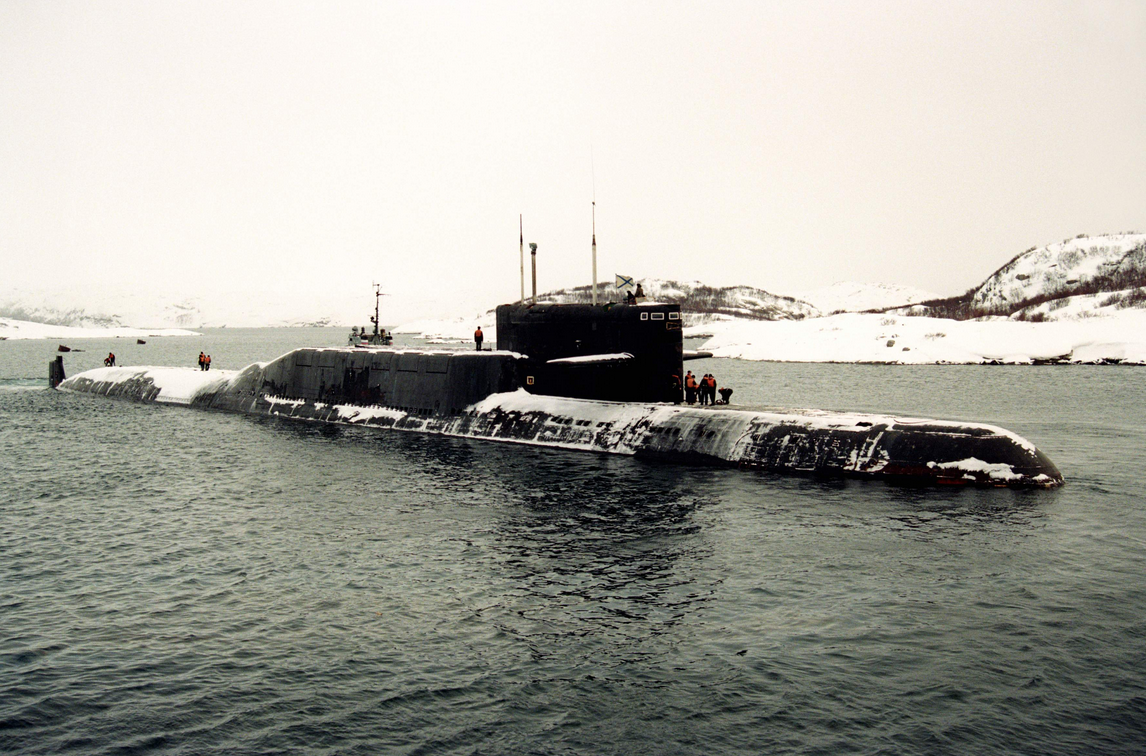
Nice photo of a Murena in the nothern fleet, 1990s. Src saturnax via reddit
Below are those built by the Sveromorsk Plant:
 K-279
K-279
K-279 hull number 310, laid down 03/30/1970, launched 12/20/1971 and commissioned on 12/27/1972, decommissioned on 1992, disposed of in 2001. Here is her career in detail to have an idea of the whole lot:
February 6, 1970: She is ordered. On March 30, she is laid down at the slipway at workshop No. 50, Sevmashpredpriyatie in Severodvinsk. Lead ship of project 667B Murena. On December 20 1971, she is launched and afterwards delivered for outfitting at the plant’s facilities. By December 27 1972, a year after, she is completed, and started yard’s tests. For first time in the history of the submarine fleet, her commander V.N. Frolov is awarded the rank of rear admiral and awarded the Order of Lenin. On January 22 1973 she is accepted in the Northern Fleet, 41st Brigade, 3rd Division based in Yagelnaya Bay in Saida Bay (Gadzhievo, Murmansk Oblast). Tests of her ballistic missiles D-9 commenced with 6 tests launches of her R-29 missiles. By May 1974 all her tests are completed and her crew is fully qualified in all departments. As part of the division, she os redeployed to Ostrovnoy (Gremikha) as part of the 11th Brigade.
She stayed at the base in 1974 base. Her power supply comed from her reactor and not an external power line at the Serebryanskaya hydroelectric station, which will be operational only in the spring of 1975. In December her crew is awarded with the “excellent” rating. By Febriary 1975 until May, 2 her final preparations and qualifications are made for her second crew under commander Capt. 1st Rank Kholod V.V.. In 1976 from March 5 to May 22 she made her first autonomous patrol in the South Atlantic, but with her first crew under commander V.P. Frolov, the second crew is transferred to the second boat of the class.
In 1976 she is in drydock at SRZ-10 Polyarny for fixes and maintenance. The tightness of of her pressure hull however is showing weaknesses, and during inspection in dry dock cracks ar located at tank No. 3 after a purge with the seams closed. The automation system failed, followed by a air explosion in the outer hull. The damage is quickly repaired.
By July, 25, 1977 she is reclassified as a guided missile submarine, but during an inspection by the Ministry of Defense, one R-29 rocket explodes during the firing tests, and it was later establushed as a factory defect.
In 1979 she is repaired at Zvezda, Severodvinsk and by May 27 1980 to Feburary 2, 1982 under L.D. Abramov she is undergoing more tests;
In 1982 her crew participated to the Navy competition “Reliable protection for the peaceful labor of the Soviet people”. In 1982 her second crew under Capt. 1st Rank Golenkov Yu.A. is requalified by a patorl under ice over 17 days. On 10 November 1982 she os on the Honor Board of advanced units and ships of the USSR Ministry of Defense an from December 18 1982 to May 30, 1983 she makde her first operaironal patrol in the White Sea throughout the winter, 164 days, before melting ice in spring. There is a welcome crew change carried out by the icebreakers “Peresvet” and “Captain Nikolaev” in March 4-7. The First crew was under command of capt. 1r. Zhuravlev V.A. (48 days under ice) and commander Capt. 1st R. Golenkov Yu.A. (61 days).
19 August 1983 until 20 October under Cap. 1st Rank V.A. Zhuravlev she operated in the Baffin Sea. On 13 Sept. 1983 at 21.13 she is cruising under 197 meters at 7 knots when colliding with an iceberg, her trim taking 45° and she hit the bottom under 287 meters. At that time, science was unaware of such dephts for an iceberg. The common figure given was 160 meters. The torpedo tubes were damaged by the impact, and the torpedos removed and secured on deck in compartment 1. There were no casualties and she successfully returned to base. This cruise lasted for 47 days.
By November 1983 November until December she had her propeller replaced at the Zvezdochka Shipyard, Severodvinsk.
By May 1984 a sailor died during the dive on May 14-18. He was one of the young recruits newly arrived. The enquiries showed he was Uzbek and aparently did not mastered Russian. Working as an auxiliary worker in the galley carrying out food waste for throwing it out through the hatch under the missile deck. The senior assistant commander did not look into the hatch but shouted “Everyone down, dive in 5 minutes!” after which the assistant apparently got scared and hid. He was not reported at first also by Section commander Capt. Lt Savin S.G.
Also in 1984 there was a steam generator issue, fixed at Severodvinsk during her yearly maintenance.
From October to December 1986 she received her second crew under commander 2nd R. Afanasenkov B.V., making another patrol escorted by K-457. On October 30-31, 1986 she was in the Atlantic when colliding with the US Navy USS Augusta (SSN-710, a “Los Angeles” type) shadowing her close. Damage was suspected minor though and she proceeded in her mission. Damage was greated to USS Augusta, forcing her back to Groton for repairs (cost 2.7-3.0 million dollars). By December K-279 made a foray on a little-studied area of the Greenland Sea and hit the bottom. Damage was also minor. On 12/10/1986, as she returned in the Barents Sea, she collided with the ship Kalininsk, but only her outer hull was damaged. She had emergency repairs at SRZ-10 in Polyarny.
In 1988 she departed with her second crew under commander – Capt. 1st Rank Karamyshev A.M., again escorted by K-472 and both cruised under ice for 9 days.
By May 1990 she is sent to Zvezda, Severodvinsk for a major maintenance.
In the summer she hosts the first crew from K-447 under Capt. 1st Rank A.V. Skiba, with an exchange. K-279 crew is transferred to K-447.
Bu 19 June 1991 she is in drydock for mid-life modernization as USSR collapses. The work is postponed.
By March 14, 1992 due to lack of funding, she is decommissioned, Delivered to OFI, laid up in the waters of Severodvinsk and her 2nd crew is disbanded.
In 1993 her scrapping commences, her missile compartments is cut out, her hull was moved to another division in anticipation of further breaking up. But she stays as it for many more years.
October 4 2001 saw a ceremony, her St. Andrew’s flag is lowered, and she had a civilian crew from Zvezda yard to proceed to her transfer to a recycling facility, between December 2001 and 2002
her dismantling commences in in floating dock No. 52 at Zvezda with much attention paid on her reactor unit, later transferred for temporary storage afloat at Nerpa.
By October 2004 these compartments are transferred to Pallada and some transferred to Saida Bay, placed at the Saida temporary storage facility for long-term.
Her first crew was awarded the pennant of the USSR MoD for courage and military valor.
 K-447
K-447
K-447, renamed in 1999 “Kislovodsk”. Hull number 311, laid down 03/18/1972, launched 12/31/1972, completed on 09/30/1973, decommissioned, 2004, disposed of the same year.
 K-450
K-450
K-450, hull number 312, laid down 07/30/1971, launched 04/15/1973, completed and commissioned on 12/29/1973, decommissioned 1993 and Disposed of in 1998.
 K-385
K-385
K-385, hull number 324 was laid down on 10/20/1971, launched on 06/18/1973 and completed on 12/30/1973. She was commissioned on 1994 and disposed of in 2003.
 K-457
K-457
K-457, hull number 325, laid down 12/31/1971, launched 08/25/1973 and completed 12/30/1973. She was decommissioned 1999 and disposed of in 2003.
 K-465
K-465
K-465, hull number 326 was laid down on 03/22/1972, launched 12/02/1973 and commissioned on 09/30/1974, decommissioned in 1994, Disposed of in 2000
 K-460
K-460
K-460 (hull number 337) was laid down 06/05/1972, launched on 02/07/1974 and commissioned on 09/20/1974, she as decommissioned in 1995, disposed of in 1998.
 K-472
K-472
K-472 (hull number 338), was laid down on 08/10/1972, launched on 04/26/1974, commissioned on 11/14/1974. She was decommissioned in 1995 and disposed of in 1998.
 K-475
K-475
K-475 (hull number 339), was laid down on 10/17/1972 and launched 06/25/1974 12/23/1974, she ws decommissioned in 1995 and disposed of in 1998
 K-171
K-171
K-171 (hull number 340) was laid down on 01/24/1973, launched 08/04/1974 and commissioned on 12/29/1974. From she was trabsferred to the 1994 Pacific Fleet, decom. 1995, disposed of in 2001.
Below are those built at the Lenin Komsomol Plant (Komsomolsk-on-Amur):
 K-366
K-366
K-366 (hull number 221) was laid down on 03/06/1973, launched on 06/08/1974 and completed on 12/30/1974, she ended her career in the Pacific Fleet in 1993 and was disposed of in 2003.
 K-117
K-117
K-417 (hull number 222) was lmaid down on 05/09/1974, launched 05/06/1975 and commissioned on 12/20/1975, she ended in the Pacific Fleet by 1995, disposed of in 1999.
 K-477
K-477
K-477 (hull number 223) was laid down on 12/05/1974, launched on 07/13/1975 and completed on 12/30/1975. She was with the Pacific Fleet in 1995 and was disposed of in 2003.
 K-497
K-497
K-497 (hull number 224) was laid down on 02/21/1975, launched on 04/29/1976 and commissioned on 10/31/1976, she was with the Pacific Fleet in 1995. She was disposed of in 2003.
 K-500
K-500
K-500 (hull number 225) was laid down on 07/25/1975, launched on 07/14/1976 and commissioned on 12/19/1976, she served with the Pacific Fleet by 2000 was disposed of in 2004.
 K-512
K-512
K-512 (renamed in 1988 “70 years of the Komsomol”) had the hull number 226. She was laid down on 01/21/1976, launched on 09/26/1976 and commissioned on 08/18/1977, she ended with the Pacific Fleet in 1995 and was disposed of in 2003.
 K-523
K-523
K-523 (hull number 227) was laid down on 07/01/1976, launched on 05/03/1977 and was commissioned on 10/30/1977, she ended with the Pacific Fleet in 1995 and was disposed of in 2000.
 K-530
K-530
K-530 (hull number 228) was laid down on 05.11.1976, launched on 23.07.1977 and commissioned on 28.12.1977 with the Pacific Fleet. She was decommissioned on 1999 and disposed of in 2001.
Read More/Src
Books
Conway’s all the world’s fighting ships 1947-95
Jane’s Fighting Ships of the World, 1999.
Jackson, Robert (2006). The Encyclopedia Of Warships, From World War 2 To The Present Day. San Diego: Thunder Bay Press.
Links
http://www.deepstorm.ru/DeepStorm.files/45-92/nbrs/667B/list.htm
On ru.wikipedia.org
navweaps.com/
web.archive.org/ www.k460.org.ru/
web.archive.org submarine.id.ru/
https://web.archive.org/web/20131030164244/http://www.kommersant.ru/doc/856043
https://www.tandfonline.com/doi/full/10.1080/00963402.2021.1885869
https://web.archive.org/web/20060410054823/https://www.navy.mil/navydata/cno/n87/history/cold-war-asw.html#PhaseIV
http://rusnavy.com/news/newsofday/index.php?ELEMENT_ID=13244
https://www.globalsecurity.org/wmd/world/russia/667b.htm
https://web.archive.org/web/20011220150652/http://www.aeronautics.ru/archive/fleet/russian/667.htm
http://www.hazegray.org/worldnav/russia/
Videos
Model Kits
Soviet submarine project 667 B Murena NATO name Delta I OKB Grigorov | No. 700057 | 1:700
Project 667B Murena Delta I Class Submarine. Polar Bear | No. | 1:350




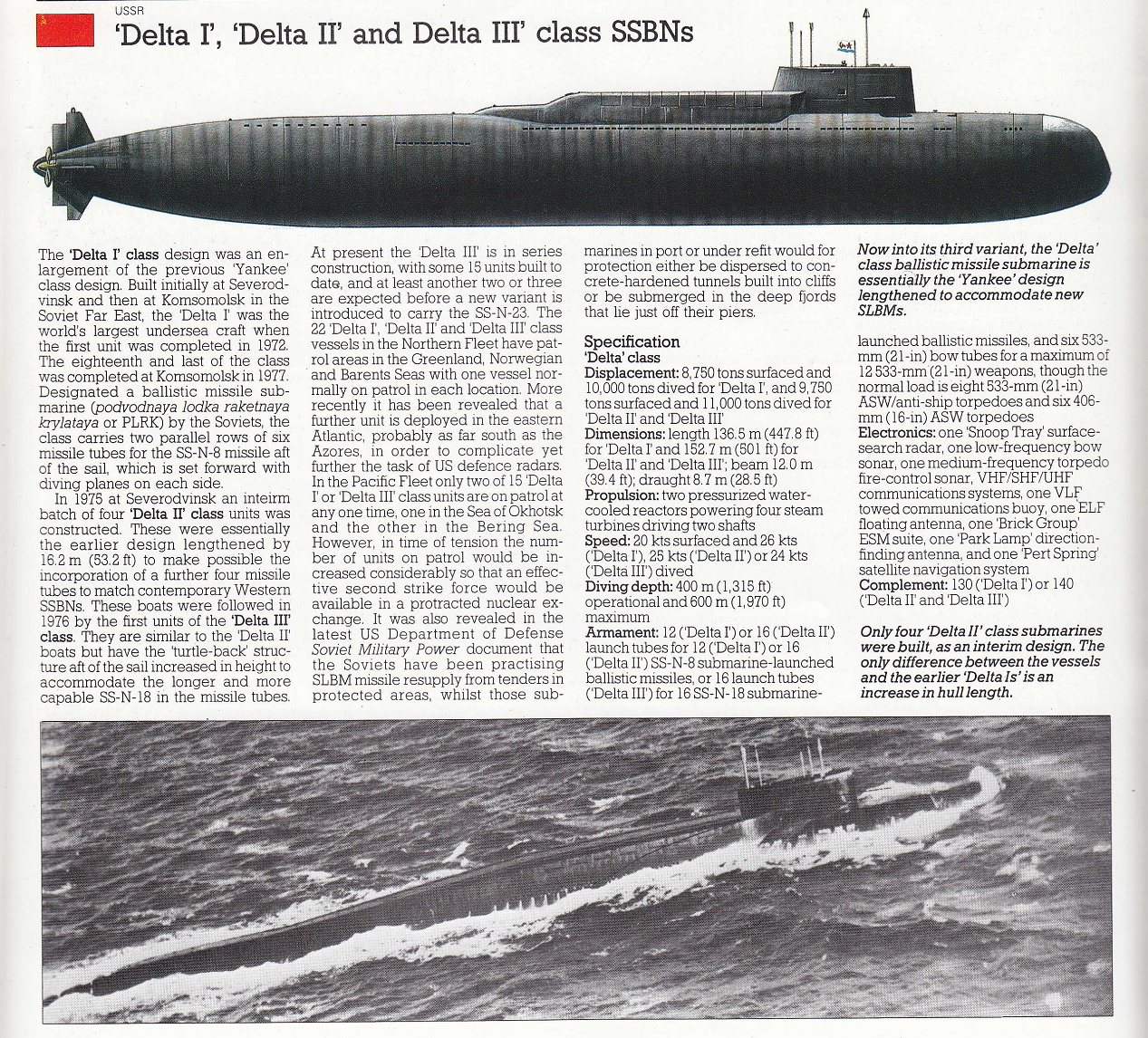
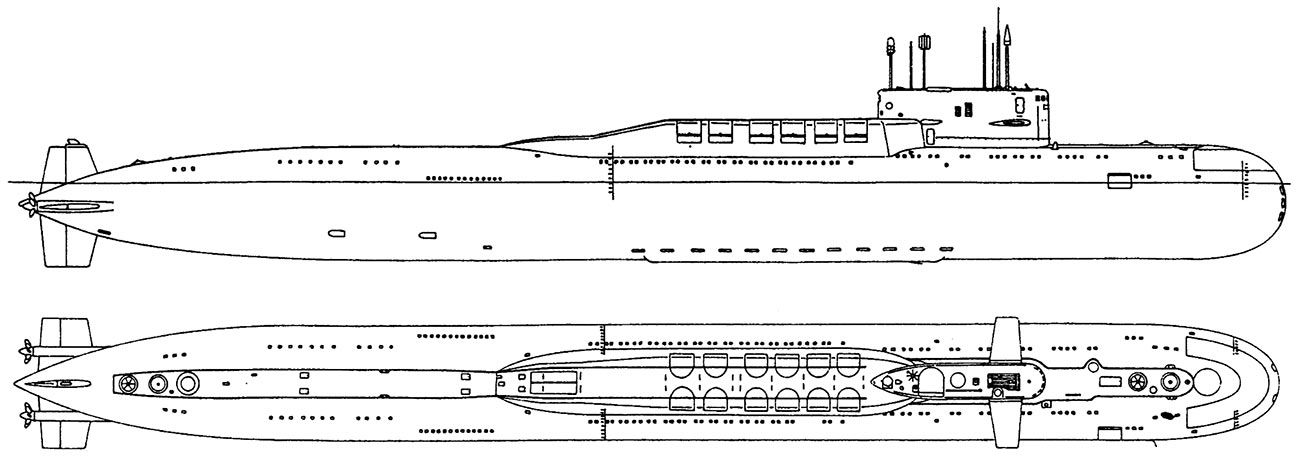
 Latest Facebook Entry -
Latest Facebook Entry -  X(Tweeter) Naval Encyclopedia's deck archive
X(Tweeter) Naval Encyclopedia's deck archive Instagram (@navalencyc)
Instagram (@navalencyc)





 French Navy
French Navy Royal Navy
Royal Navy Russian Navy
Russian Navy Armada Espanola
Armada Espanola Austrian Navy
Austrian Navy K.u.K. Kriegsmarine
K.u.K. Kriegsmarine Dansk Marine
Dansk Marine Nautiko Hellenon
Nautiko Hellenon Koninklije Marine 1870
Koninklije Marine 1870 Marinha do Brasil
Marinha do Brasil Osmanlı Donanması
Osmanlı Donanması Marina Do Peru
Marina Do Peru Marinha do Portugal
Marinha do Portugal Regia Marina 1870
Regia Marina 1870 Nihhon Kaigun 1870
Nihhon Kaigun 1870 Preußische Marine 1870
Preußische Marine 1870 Russkiy Flot 1870
Russkiy Flot 1870 Svenska marinen
Svenska marinen Søværnet
Søværnet Union Navy
Union Navy Confederate Navy
Confederate Navy Armada de Argentina
Armada de Argentina Imperial Chinese Navy
Imperial Chinese Navy Marinha do Portugal
Marinha do Portugal Mexico
Mexico Kaiserliche Marine
Kaiserliche Marine 1898 US Navy
1898 US Navy Sovietskiy Flot
Sovietskiy Flot Royal Canadian Navy
Royal Canadian Navy Royal Australian Navy
Royal Australian Navy RNZN Fleet
RNZN Fleet Chinese Navy 1937
Chinese Navy 1937 Kriegsmarine
Kriegsmarine Chilean Navy
Chilean Navy Danish Navy
Danish Navy Finnish Navy
Finnish Navy Hellenic Navy
Hellenic Navy Polish Navy
Polish Navy Romanian Navy
Romanian Navy Turkish Navy
Turkish Navy Royal Yugoslav Navy
Royal Yugoslav Navy Royal Thai Navy
Royal Thai Navy Minor Navies
Minor Navies Albania
Albania Austria
Austria Belgium
Belgium Columbia
Columbia Costa Rica
Costa Rica Cuba
Cuba Czechoslovakia
Czechoslovakia Dominican Republic
Dominican Republic Haiti
Haiti Hungary
Hungary Honduras
Honduras Estonia
Estonia Iceland
Iceland Eire
Eire Equador
Equador Iran
Iran Iraq
Iraq Latvia
Latvia Liberia
Liberia Lithuania
Lithuania Mandchukuo
Mandchukuo Morocco
Morocco Nicaragua
Nicaragua Persia
Persia San Salvador
San Salvador Sarawak
Sarawak Uruguay
Uruguay Venezuela
Venezuela Zanzibar
Zanzibar Warsaw Pact Navies
Warsaw Pact Navies Bulgaria
Bulgaria Hungary
Hungary

 Bundesmarine
Bundesmarine Dutch Navy
Dutch Navy Hellenic Navy
Hellenic Navy Marina Militare
Marina Militare Yugoslav Navy
Yugoslav Navy Chinese Navy
Chinese Navy Indian Navy
Indian Navy Indonesian Navy
Indonesian Navy JMSDF
JMSDF North Korean Navy
North Korean Navy Pakistani Navy
Pakistani Navy Philippines Navy
Philippines Navy ROKN
ROKN Rep. of Singapore Navy
Rep. of Singapore Navy Taiwanese Navy
Taiwanese Navy IDF Navy
IDF Navy Saudi Navy
Saudi Navy Royal New Zealand Navy
Royal New Zealand Navy Egyptian Navy
Egyptian Navy South African Navy
South African Navy






























 Ukrainian Navy
Ukrainian Navy dbodesign
dbodesign